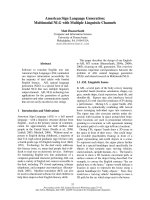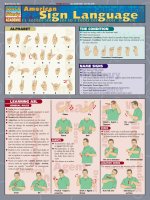BarCharts quickstudy american sign language
Bạn đang xem bản rút gọn của tài liệu. Xem và tải ngay bản đầy đủ của tài liệu tại đây (1.85 MB, 4 trang )
BarCharts, Inc.®
WORLD’S #1 ACADEMIC OUTLINE
A mer ica n
Sign Language
r
a
a
b
k
c
h
i
d
p
u
v
f
k
q
l
m
r
w
x
GENERAL RULES
n
NAME SIGNS
Date back to 19th century
Used for identification
Arbitrary Name Signs (ANS)
Arbitrary
t
• Uses manual alphabet (can be two letters - must be signed with double motion)
• Sign located on body or in front of signer
• Short/double letter names may not have name signs
m
Descriptive Name Signs (DNS)
Descriptive
• Depict information about personality/physical characteristics
• Signed with double movement
• Proper names need to be introduced before a name sign is used
z
Chair
Plane
Store
AGENTS
Fly
Teach + Agent =
Teacher
VERBS
To personify a sign, add
an agent after the sign
Personification is done
by sliding the heel of the
hands down the side of
the body from chest to
waist
Also known as a marker
We were defeated
The action is signed on the location of the referent
Drive + Agent =
Driver
1
We defeated them
LOCATIVE VERBS
Agent
Preach + Agent =
preacher
Fly + Agent =
Pilot
In ASL, verbs take on different functions
For example, with multidirectional verbs, the sign
is made toward the direction of the referent:
Sell
Agent
We
Standing
Sit
Unmarked Handshapes
Driver
Sit
General
g
Pilot
Learning
Rules
y
Condition
Store
Verbs have a single motion
Verbs are not mouthed; mouth movement is used
to express adjectives and adverbs
Nouns have a double motion
Adjectives can be incorporated into the noun
When a noun acts as an adjective, the word order
does not change; for example: grass skirt, health
chart, fruit juice
Adverbs can be incorporated into the verb
The adverb will always answer the question of
how the verb was performed
ASL is high contextual; the person doing the
action needs to be identified--an explanation of
how the subject and circumstances come together
before the action (verb) occurs
English is low contextual - a prior knowledge of
the subject is not necessary; therefore, English
can be spoken in a passive tense while ASL is in
an active tense
Nouns are signed with a double motion (tapped
twice); verbs are signed with a single - motion;
nouns are usually "mouthed" or pronounced;
verbs are not. Some examples:
s
Hand one writes with is the dominant hand
Other hand is passive
Dominance Condition: Passive hand in unmarked shape when signing
Symmetry Condition: Both hands in same shape moving alternately or in
the same direction
Teacher
LEARNING ASL
Chair
s
w
j
d
o
e
THE CONDITION
Alphabet
ALPHABET
Hurt left arm
Hurt left arm
Standing on
surface
Reciprocal
- It is signed with the head slightly shaking "no"
and the mouth is usually opened
Time Indicator Sentences
• These sentences start with time verbs
• If time is not signed at the beginning of the
sentence, it should be placed as close to the subject
as possible (in ASL the subject will be at the
beginning of the sentence)
• Some time adverbs are: now, soon, tomorrow, next
year, last summer and recently
• The time indicator will allow the addressee to
understand if the sentence is past, present, or future
Conditional Sentences
• Like the topic/comment, conditional sentences are
stated in two parts
• Conditional sentences must have the condition first
• The comment will always be about the referent in the
condition (the first part)
• Generally, conditional sentences are futuristic
• When signing the condition, eyebrows are raised; they
will be lowered (with comment about the condition)
Conditional
Exchange info
NEGATION AND AFFIRMATION
True
Will
SENTENCE STRUCTURE
• Simple yes/no questions do not require ASL word
order; however, if the yes/no question requires
explanation before a yes/no response, ASL word
order and sequence of events is needed
• The appropriate physical information is head tilted
forward, shoulders raised, and eyebrows up; the eyes
will naturally open more than usual
Questions Seeking Information
• Questions which ask who, what, when, where, why and
how are asked at the beginning and end of the sentence
• There will usually be a "hold" (pause) after the question
at the end of the sentence--this is done for emphasis
• The head is tilted to the side, eyebrows down and
close together
Present
recent
future future
far
future
Adverbial Time
far
past
past
recent
past
• In ASL, adverbial time indicators are placed at the
beginning of the sentence, or as close to the subject
as possible
• In English, adverbs are placed in any part of the
sentence
• In ASL, time indicators qualify (measure) time
expected or time expired
• Signs behind the body refer to the past
• Signs directly in front of the body refer to the
present, today or now
• Signs extended in front of the signer refer to the
future; like the signs which are extended behind the
body for the past, the extension of the arm
determines the degree of how far past or how far into
the future
• Facial expression will assist the time indicator
• Finish/Not Yet
"Finish" allows the addressee to understand the
information is past tense
- It is also signed when joking, meaning
"enough already"
- It is also signed in admonishment, meaning
"stop it"
- Context and facial expression will determine
the signer’s intention
- "Finish" can be placed at the beginning or end
of a sentence
Finish
Look at- over time
Look at- regularity
Look atlong time
Look atrepeatedly
• Indexing
Pronouns in ASL can be signed by pointing to a
referent; this is also called indexing
Indexing can be done with the finger, a head nod,
or eye gazing (visual indexing)
• Possessive Pronouns
Singular
- To express possessive pronouns, an open hand
toward the referent will indicate his, hers
- A hand on one’s chest will indicate mine
Plural possessive is shown with the open hand
toward one referent; the hand makes a sweeping
motion inclusive of all referents
Indexing
Indexing
Singular
Finish
"Not yet" refers to action that has not taken place
- The intended action is signed, then "not yet" is
stated
- It is placed at the end of the sentence
2
Singular
Comment
There are several sentence structure types in ASL.
Here are a few:
Topic Comment
ASL is structured by the order in which an event
occurred; the topic is mentioned first, the subject of
the event, then a comment about the topic/subject
Yes/No Question
Adverbial Time Indicators
Sentences
Negation
Simple Sentence Structure
• This short sentence can use any word order
• A simple sentence will have a subject (referent) and
verb (action concerning the referent)
• Temporal Aspect
Found in the predicate of a sentence, as verbs
come after the noun in ASL
Tells how the action is performed
Also explains how the action is signed in reference
to time
Look at
When the sign "not" is put at the end of a
sentence, negation is added
Sometimes the head shaking "no" also will be
signed with "not"
Affirmation is usually
done with the signer
making a statement then
signing "will" at the end
of the sentence
The
head
nodding
slightly backward and
forward
with
the
eyebrows raised are also
appropriate nonmanual
Not
markers
One can also sign "true" at the end of the sentence
while using such non-manual markers as a head
nod with tight lips (to emphasize a statement)
Not yet
Not Yet
RECIPROCAL VERBS
The signer uses both
hands in the same
hand shape; one
hand represents the
signer while the
other hand represents
Look at each other
the addressee
If the signer is asking a rhetorical question, the head
will be tilted to the side or forward, eyebrows up
Sometimes it takes a more fluent signer to
understand that the question is rhetorical
True
LEARNING ASL CONT.
Plural
Sentence Structure, continued
Mexico
ASL has many country name signs to identify a
country as a referent; however, living in the Age
of Information, it is becoming more politically
correct for ASL users to adopt indigenous name
signs from respective countries
There are two reasons for this adoption:
• Deaf communities now have access to such information
• Some American country name signs, like other
countries, have offensive signs for countries which
they represent
America
China
China
Saturday
Japan
England
White
Red
3
Friday
Germany
Red
Green
Thursday
(Randomly wiggle fingers)
Blue
Green
Wednesday
Sunday
France
Canada
Tuesday
Sunday
(Thump chest twice)
The depth of color can be incorporated into the
noun by facial expression
Color will come after the referent it is
describing
Orange
Monday
Germany
COLORS
Blue
Monday
Plural
America
Mexico
Days of the Week- Act as time indicators and
should be placed at the beginning of the sentence
England
COUNTRIES
WEEKDAYS
Wednesday
Expressions
- Moving outward from the passive hand (in the
same hand shape), the dominant hand indicates
rows of the referent
- After the referents have been established, the
signer can continue the discourse
• Non-Manual Markers
Facial grammar, body language, and eye contact
contribute to well over 50% of sign language
expressed by a fluent signer
Fluent signers also tend to look at the facial, throat
and shoulder areas when watching other signers
because much information can be expressed
through these body parts
Facial expression covers many components in a
message
- It will indicate how an action is performed, how
fast or slow it was performed, and if it was
performed conscientiously or carelessly
- It can indicate the degree in size, shape and color
Adverbs and adjectives can be expressed through
facial expression
Eye contact has importance of its own; eye
shifting, eye indexing, eyes wide open, eye
gazing, eye squinting, or breaking eye contact all
work together with body language and head
movement to set up referents of people and
objects in a spatial location
Body language is equally important; tilting the
head, raising the shoulders, and body shifting are
all indications of change in a sentence or who is
being talked about
Markers
Classifiers
As in English, a pronoun in ASL requires a noun
to be stated before a pronoun can be used
• Loan Signs
All languages "borrow" from each other; loan
signs are words borrowed from English
In ASL, they are usually two letters: the first and last
- There is usually a distinct hand movement for
words that are borrowed and have more than
two letters
- For example, "early" is signed in a circular
motion; "style" is signed in an up/down motion
• Classifiers
Express and represent descriptive qualities of
nouns (referents); their shapes, sizes, degree of
color, actions, locations in space and whether they
are singular or plural content
There are certain signs that are used to establish a
classifier’s discourse
Before using a classifier, a subject noun must be
identified; like pronouns need a referent
Classifiers are signed with the passive hand; the
action the classifier encounters with the verb is
signed with the dominant hand
If the classifier is singular and describing the shape or
size, the referent will be in close proximity
Plural classifiers require both hands
To show random order, alternating movement of
the hands is necessary
To show an orderly arrangement, the passive hand
is stationary while the dominant hand provides the
movement and pluralization by moving in a linear
fashion
Black
White
Colors, continued
Pink
Pink
Yellow
Purple
Purple
Gray
Gray
Yellow
Brown
NUMBERS 1 – 20
10
CREDITS
Author: Adan R. Penilla II
18
Six
5
8
6
9
Twelve
11
12
U.S. $4.95
CAN. $7.50
NOTE TO STUDENTS
This QuickStudy® guide is an outline of the major topics taught in American
Sign Language courses. Keep it handy as a quick reference source in the
classroom, while doing homework, and as a memory refresher when reviewing prior
to exams. Due to its condensed format, use it as an ASL guide, but not as a
replacement for assigned class work.
15
Baseball
16
17
Tennis
Tennis
Golf
Golf
Twenty
19
Boxing
20
SPORTS SIGNS
Sports signs are iconic (they look like what they
represent); however, they can be used in the subject
Football
7
3
14
Gold
Boxing
4
2
Nine
Seven
1
Twelve
Three
13
Baseball
NUMBERS AND SPORTS
In the numerical system, one through five are
signed with the palm facing the signer
Six through ten are signed with the palm facing
the addressee
Eleven through fifteen are signed with the palm
facing the signer
Sixteen through nineteen are signed: ten, six; ten,
seven; ten, eight; ten, nine
Twenty is signed with the index finger and the
thumb tapping two times
Brown
Gold
COLORS
Cycling
Basketball
Cycling
Wrestling Swimming
Football
Wrestling
Customer Hotline # 1.800.230.9522
We welcome your feedback so we can
maintain and exceed your expectations.
ISBN-13: 978-142320385-8
ISBN-10: 142320385-2
All rights reserved. No part of this publication may be reproduced or transmitted in any form, or by any means, electronic or
mechanical, including photocopy, recording, or any information storage and retrieval system, without written permission from
the publisher. © 2001, 2004 BARCHARTS INC. Boca Raton, FL. 0707
4
Bowling
Swimming
hundreds of titles at
quickstudy.com




![English Learning - Speak English Like an American - 2004 [Language Success]](https://media.store123doc.com/images/document/2016_11/17/medium_dgw1479375411.jpg)




